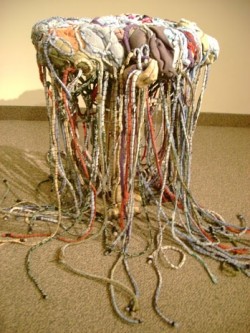What happened here? Susan McClelland's installation of soft/hard sculpture looks as if a puppy got loose in an attic, chewing and dragging old pajamas and quilts over not-so-gently used furnishings like chairs, a lamp and a bed. And yet McClelland's tangled objects in Accumulations Retraced have a logic all their own. The recent Kent State University graduate's stitched, stained fabrics and furnishings aren't so much random as radically loose, like thick, soft skin, freckled and pouched with time and secrets.
Household dust, we're told, is made up in part of cast-off human skin; even the cleanest home is a library of DNA. Similarly, personal history is encoded - organically, economically, psychologically - in the things people use every day, the beds they sleep in, the clothes they wear, the fabrics that cover and warm, decorate and disguise. If art is an instrument made to search for identity, and meaning is a sort of prosthesis for the worldly ambitions of the soul, McClelland has assembled artificial limbs to walk through the inner realities of domestic space.
"Journal" is constructed of many small, rectangular fabric squares about the size of Post-it Notes. McClelland stitches everything together with black thread in long loops, colored with a range of dyes and shaped with wire, that swing up one gallery wall, then spread out over the floor in two long sequences, like a story with alternate endings. The work's wide, scribbling gestures vaguely resemble penmanship magnified, layered and distorted in a dream, a chain of diary entries joining to evolve a life story of their own. McClelland writes that her work has to do with memory - not only the narratives we construct to describe our experience, but deep banks of unconscious knowledge, drifting on the floor of the collective, instinctual mind. The gallery is a beach at the edge of forgetting, where things we used to know are stranded and changed.
"Accumulation," made of blankets and nylon crochet thread, stained with tea and bunched onto a simple, armless chair frame, seems bleached and partially melted by mysterious pressures. It's among the most successful of McClelland's objects partly because, while retaining vague chair-like outlines, it most strongly resists overt resemblance to any actual household object. Like a portrait of a chair done from the point of view of the furniture itself, it records the imprint of long human use, infected and swollen with people's lives, displaying a sense of identity not human but constructed from human warmth, damage and elaborate attempts at repair.
There is something viral about McClelland's adaptations of familiar things, as if a transformed history of domestic use is about to burst through the host membrane. This may already have happened with "Untitled," which is, or once was, an end table. In the gallery, padded and draped with layers and dreadlocks made of her siblings' blouses (the artist grew up in a household with four sisters) coiling along the gallery floor, it's more like a Medusa jellyfish or some kind of carnivorous plant. That impression is only reinforced by an eerie plaster hand, reaching out from under the tabletop and grasping one of the table's tentacles.
Where McClelland's installation describes experience and personal history as yielding and softly, dangerously enveloping, artist Don Henson - who received his M.F.A. from Kent State and currently works at the University of North Carolina at Chapel Hill - makes cruel-looking sculptures that seem designed to measure and penetrate their environment. There are only three works in Henson's show, In Fluid Space, at the Sculpture Center's gallery fronting on Euclid Avenue, but they fill the room with watchful menace.
Henson makes his high-design objects from gleaming, machined aluminum and black-painted cast resin or wood, combining science-fiction visions with an interest in the ways line and volume can be employed to bend and dominate the space they occupy. The six-foot "Leech" malingers in a far inside corner, like a nightmare waiting to happen. Six aluminum feelers spread out from its "head," as its colon-like body bulges in a long, wrinkled black tube down to the floor. The last two feet or so are clear plastic tube, terminating in an aluminum spike or stinger. It's not a work you want to get too close to.
Across the gallery near the front windows hangs "Seeker," suspended from wires attached to walls, ceiling and floor by conical sensors, scopes monitoring or maybe sucking up esoteric energies. The wires branch out from aluminum teats or nodules obtruding from the over-all black, tuberous object, with a penile form at one end and a metal nipple terminal shape at the other. This end of the room is also off-limits, and it doesn't get any safer: A few feet away, the center of the gallery has been staked out by Henson's largest work,"Heiffer." The three-foot-tall, six-foot-wide, eight-foot-long cast resin object looks like a big black larva, struggling to turn itself over onto incongruous appendages that resemble decorative posts. Wallowing with its wrinkled midriff on the gallery floor, it looks heavy, as if it just swallowed several art lovers. Especially disturbing is a puckered hole indented where its head ought to be.
Henson's three works envision a not necessarily distant future in which mechanical and organic components fuse. Like semi-robotic plants, they're engineered for purposes we can only fantasize about. A kind of sexual energy is evoked by their sadomasochistic appearance, but also the opposite - an unbridgeable separation from the natural world rather than any kind of passion, even for death. Henson's strange visitors may suggest penetration, but they are too isolated to actually connect to the dimension they occupy or anything in it, even with violence. Instead they describe extreme alienation, trapped in fetishistic, tightly wrapped aggression, like insects immobilized in a spider's web. Henson's objects are embalmed elegies to form, in a time when the natural boundaries distinguishing scale, substance and function have been breached by science and technology, soon to disappear without trace. Like McClelland's work in this respect, they're harbingers of a world that will not be home, or at least not ours. [email protected] Sculpture Center Emerging Artist Series: Susan McClelland and Don Henson January 9 Ð February 14, 2009 1834 E. 123rd St. 216.229.6527 www.sculpturecenter.org











